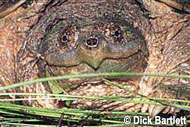Description:
Hatchling and juvenile snapping turtles are interesting and docile animals. They seem to acquire the adult aggressive at age 3 or 4. However, common snapping turtles grow rather quickly and a small juvenile will soon become too large for the typical household aquarium. Adults do not make good pets and can inflict a painful bite. Juveniles can be kept in aquariums with shallow water. They are not particularly strong swimmers and should be given some structure to hide in, such as small logs or branches. They rarely bask, but will benefit from a multi-spectrum lighting system. Common snapping turtles are actually quite omnivorous, eating aquatic plants, as well as aquatic insects, tadpoles and crayfish. Adults will scavenge dead fish, but are unlikely to capture healthy game fish, a crime they are often accused of. Juveniles will consume turtle pellets in captivity.
Habitat:
Common snapping turtles are habitat generalists, and are found in lakes, farm ponds, shallow wetlands, small streams and river systems. They are capable of moving overland and will do so to search for new bodies of water.
Range:
The common snapping turtle’s natural range covers the entire eastern United States and southern Canada, extending from Nova Scotia and Maine in the northeast, to Florida in the south, and eastern New Mexico and eastern Montana in the west. However, common snapping turtles have been introduced outside of their natural range and have been reported from the Rio Grande in New Mexico, and are now found in many habitats in California, Oregon and Washington.
Scientific Name: Chelydra serpentina
Species Group: turtle
Family: Chelydridae
Size: More than 14 inches, generally not more than 35 lbs in the wild, however captives have been known to reach 60 lbs or more. Males are generally larger than females.
Level: advanced
Weight: N/A
Dangerous: No



